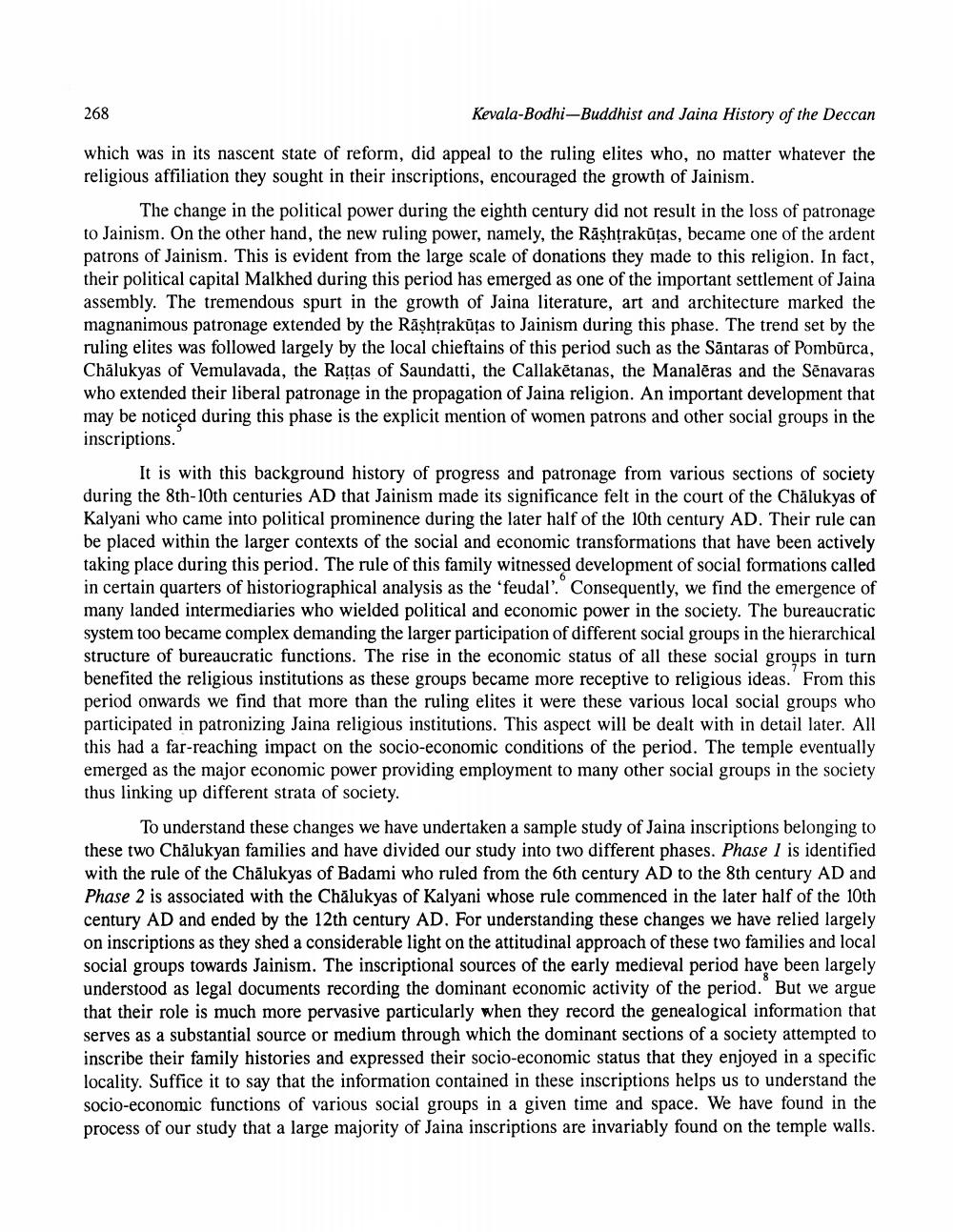________________
268
Kevala-Bodhi-Buddhist and Jaina History of the Deccan
which was in its nascent state of reform, did appeal to the ruling elites who, no matter whatever the religious affiliation they sought in their inscriptions, encouraged the growth of Jainism.
The change in the political power during the eighth century did not result in the loss of patronage to Jainism. On the other hand, the new ruling power, namely, the Rashtrakūtas, became one of the ardent patrons of Jainism. This is evident from the large scale of donations they made to this religion. In fact, their political capital Malkhed during this period has emerged as one of the important settlement of Jaina assembly. The tremendous spurt in the growth of Jaina literature, art and architecture marked the magnanimous patronage extended by the Rāşhțrakūtas to Jainism during this phase. The trend set by the ruling elites was followed largely by the local chieftains of this period such as the Sāntaras of Pombūrca, Chālukyas of Vemulavada, the Rattas of Saundatti, the Callakētanas, the Manalēras and the Senavaras who extended their liberal patronage in the propagation of Jaina religion. An important development that may be noticed during this phase is the explicit mention of women patrons and other social groups in the inscriptions.
It is with this background history of progress and patronage from various sections of society during the 8th-10th centuries AD that Jainism made its significance felt in the court of the Chālukyas of Kalyani who came into political prominence during the later half of the 10th century AD. Their rule can be placed within the larger contexts of the social and economic transformations that have been actively taking place during this period. The rule of this family witnessed development of social formations called in certain quarters of historiographical analysis as the 'feudal. Consequently, we find the emergence of many landed intermediaries who wielded political and economic power in the society. The bureaucratic system too became complex demanding the larger participation of different social groups in the hierarchical structure of bureaucratic functions. The rise in the economic status of all these social groups in turn benefited the religious institutions as these groups became more receptive to religious ideas. From this period onwards we find that more than the ruling elites it were these various local social groups who participated in patronizing Jaina religious institutions. This aspect will be dealt with in detail later. All this had a far-reaching impact on the socio-economic conditions of the period. The temple eventually emerged as the major economic power providing employment to many other social groups in the society thus linking up different strata of society.
To understand these changes we have undertaken a sample study of Jaina inscriptions belonging to these two Chālukyan families and have divided our study into two different phases. Phase 1 is identified with the rule of the Chālukyas of Badami who ruled from the 6th century AD to the 8th century AD and Phase 2 is associated with the Chālukyas of Kalyani whose rule commenced in the later half of the 10th century AD and ended by the 12th century AD. For understanding these changes we have relied largely on inscriptions as they shed a considerable light on the attitudinal approach of these two families and local social groups towards Jainism. The inscriptional sources of the early medieval period have been largely understood as legal documents recording the dominant economic activity of the period. But we argue that their role is much more pervasive particularly when they record the genealogical information that serves as a substantial source or medium through which the dominant sections of a society attempted to inscribe their family histories and expressed their socio-economic status that they enjoyed in a specific locality. Suffice it to say that the information contained in these inscriptions helps us to understand the socio-economic functions of various social groups in a given time and space. We have found in the process of our study that a large majority of Jaina inscriptions are invariably found on the temple walls.




